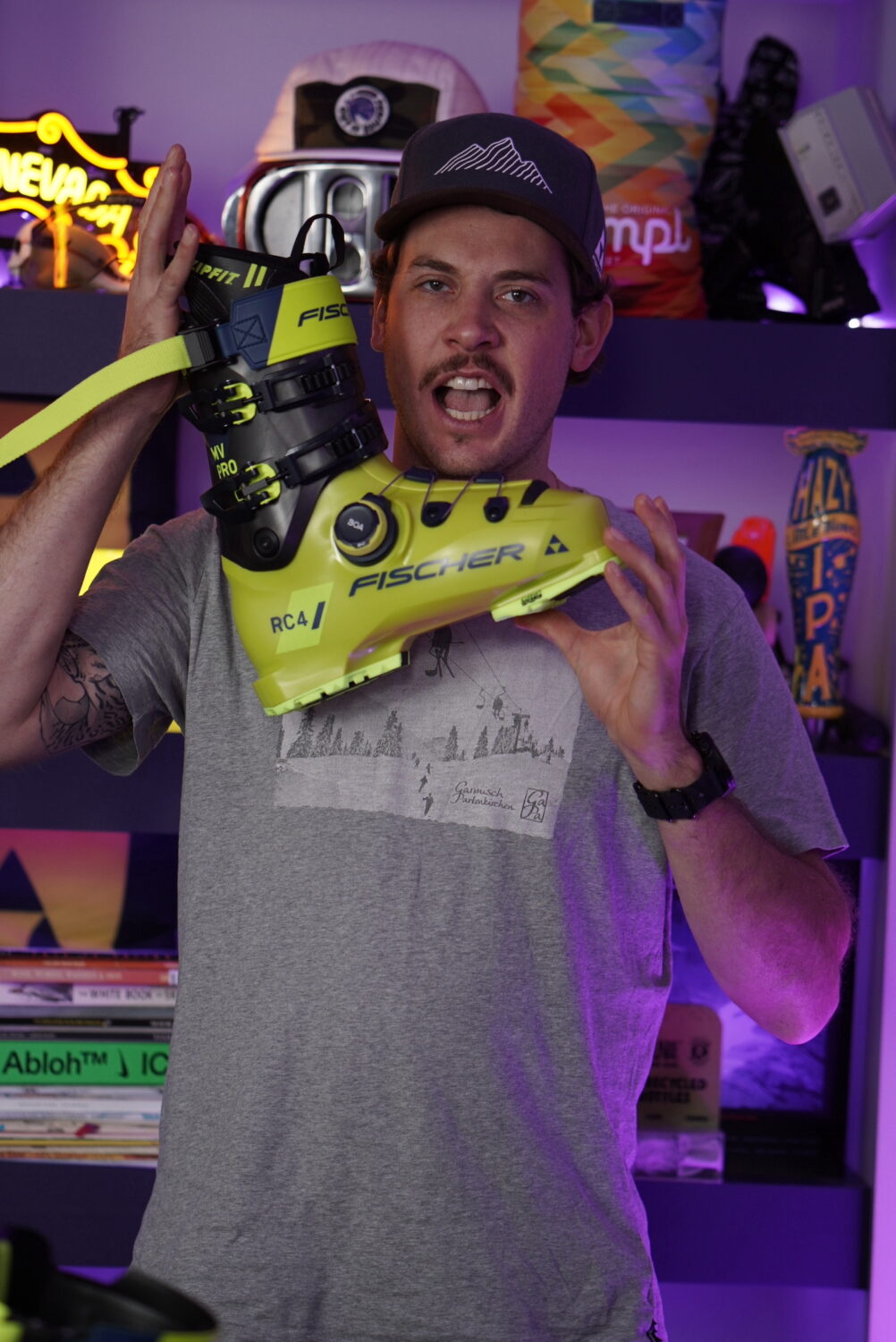
The Pursuit – E97 – The Art of Confidence w/ Amie Engerbretson
The Pursuit – E97 – The Art of Confidence w/ Amie Engerbretson Amie Engerbretson has done it all, from professional skier, to producer, podcast host and the list goes on. […]

You have probably noticed that the BOA craze has hit ski boot shells for 2023/24. Here’s a breakdown of the BOA story, its purpose, and who it’s for. So, let’s dive into why BOA ski boots make sense, and why they don’t.
Kicking off in 2001, BOA Fit Systems emerged as a new way to rapidly and effectively tighten snowboard boots. Since then, BOA has been adapted to sneakers, cycling shoes, recovery gear, helmets, and now, ski boot shells. Using a wind-up system, strung throughout the intended target area, the system tightens your product with even tension from the twist of a reel. Typically you see these in nylon, plastic, or stainless steel attached to the plastic housing unit. In footwear, the reel is pushed down and turned clockwise to tighten, and pulled out to release tension.

In snowboard boots, and now ski boots, BOA offers a stiffer feel, while tightening evenly throughout the designated area. While many different versions of BOA are available for different applications, typically you’ll see H-Series dials on snow products. This one is slightly larger and allows for compression even through the multiple layers of a boot.
One of the hottest topics in hard goods for next season is the introduction of a new BOA system designed to replace the bottom two buckles of ski boots. Four major brands will adapt this to some of their offerings – Atomic, Fischer, K2, and Salomon. The ever-so-popular Atomic Hawx, the S/Pro Alpha, the K2 Mindbender/Recon, and the all-new Fischer RC4 are the “test dummies” for year one.
A $50-$100 price increase for the system will hit every one of these models, but in many cases, a traditional buckle version will be available as well.
One of the biggest cons to the four-buckle boot for many people is the bottom two buckles. Many users find that the bottom two buckles have a crushing effect on their feet. The downward force of the buckles often ends up leaving the boot way too loose, or completely crushed, especially for those of us with higher insteps and/or wider feet. The BOA fit is just different.
Since the cable is aligned in a cross pattern over the boot, it acts almost like laces, applying a wrap-like fit to the user’s foot. For me, this is the number one benefit of all of this hoopla. As someone who is plagued by poor fits due to my higher-than-normal instep, the wrap effect makes an immediate impact on me, right out of the box. I’ve never been able to tighten those bottom buckles properly in my life, until now. This positive impact on fit isn’t just limited to paw-footed, tent-instepped people, but also to those with other foot shapes.

The cable thickness is vastly larger than what you’re traditionally used to seeing in snowboard boots or cycling shoes. I’ve actually heard the cable is strong enough to literally retain a lift chair, whether that’s true or not is for a different day. I’d be shocked if the durability of the cable itself comes into question at all. In addition, the added girth gives you the ability to, frankly, crank the shit out of this thing.
One of the issues, obviously, is that there’s a wart on your ski boot now. It’s big, it’s bulbous, and it’s in an easy-to-whack area. BOA has worked in collaboration with ski manufacturers to create a release system for impact, and it certainly works to prevent the wheel itself from getting ripped off the boot. However, when the wheel ejects, you lose all tension in the lower part of the boot. Not the end of the world, but not ideal either. It remains to be seen if the housing unit for the BOA dial itself, is actually durable. I’m sure it’s been run through the wringer, and BOA boasts a great warranty, but still, TBD.
One of the last points of contention for many consumers is the lack of individual zones. One dial, one zone, replacing two buckles. How much does this matter? I don’t know. Typically I’m running about the same buckle tension for both bottom buckles, but the option is nice.
There is of course the camp that is leaning into the “I don’t get the point” bit, and that’s fine too.
In fall 2023 you’ll see some of these specimens show up at local ski shops, some even have them now. Price points will start as low as $599 (K2) and skyrocket to $1050 (we’ll get into this one later).
Is BOA of interest to you? Can you see it adding anything to your ski experience?
Leave a note in the comments, or email us at adam@outofpodcast.com
For more: https://outofpodcast.com/reviews
Tagged as: boa boot, boa, Fischer, atomic, K2.

Adam X Sauerwein February 1, 2023
The Pursuit – E97 – The Art of Confidence w/ Amie Engerbretson Amie Engerbretson has done it all, from professional skier, to producer, podcast host and the list goes on. […]

The Pursuit – EP169 – Just Say it Somebody’s gotta address it, so let’s discuss it. Imagine if we were all just people trying to make our way around this […]

Out of Bounds – E293 – Cody Cirillo Goes for a Long Bike Ride Hello, hello, hello and welcome to a brand-new episode of The Out Of Bounds podcast, right […]

The Pursuit – EP168 – The Tour The Tour de France has begun. The XGL has teamed up with a prominent ski organization. Also, Specialized has announced a new bike, […]
Adam X Sauerwein June 26, 2024
The Pursuit – EP167 – Introducing The League With two major sporting announcements in the past month, AdamX sat down to discuss the XGames League and Shaun White’s new snow […]
© 2022 Out Of Collective
| Cookie | Duration | Description |
|---|---|---|
| cookielawinfo-checkbox-analytics | 11 months | This cookie is set by GDPR Cookie Consent plugin. The cookie is used to store the user consent for the cookies in the category "Analytics". |
| cookielawinfo-checkbox-functional | 11 months | The cookie is set by GDPR cookie consent to record the user consent for the cookies in the category "Functional". |
| cookielawinfo-checkbox-necessary | 11 months | This cookie is set by GDPR Cookie Consent plugin. The cookies is used to store the user consent for the cookies in the category "Necessary". |
| cookielawinfo-checkbox-others | 11 months | This cookie is set by GDPR Cookie Consent plugin. The cookie is used to store the user consent for the cookies in the category "Other. |
| cookielawinfo-checkbox-performance | 11 months | This cookie is set by GDPR Cookie Consent plugin. The cookie is used to store the user consent for the cookies in the category "Performance". |
| viewed_cookie_policy | 11 months | The cookie is set by the GDPR Cookie Consent plugin and is used to store whether or not user has consented to the use of cookies. It does not store any personal data. |
Andrew Gustyn on February 13, 2023
This is a great synopsis of the technology and its benefits. You mention that there is an uptick in the cost of a BOA vs. buckles, I wonder though if this move might also be driven by cost savings from the manufacturers. i.e. each BOA is identical (barring different colour options), whereas buckle systems are generally proprietary to a manuafacturer. I’d be curious to understand your sense on that. I won’t be jumping into this at least for a couple of years, but I will be keeping a close eye on what the general consensus is from the ski community.